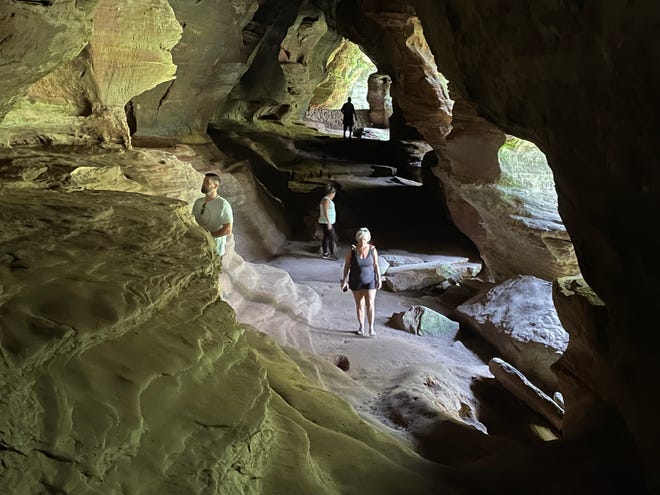

Fall hiking in Hocking Hills State Park can be exhilarating.
The park’s craggy cliffs and outcroppings, sun-dappled foliage and misty streams and waterfalls make the perfect backdrops for an autumn outing.
However, the trails can also be packed with hikers, especially on weekends along popular routes at Old Man’s Cave and Ash Cave.
For visitors looking for less company but no less scenery, several other hikes in and near the 2,356-acre state park offer trails (and parking lots) that are often less crowded than those at the more well-known sites.
Things to do in Ohio:Exploring 4 hidden gems and unseen corners of southeast Ohio

Hiking at Hocking Hills
Trails at Cantwell Cliffs, Rock House and Conkle’s Hollow State Nature Preserve are all located along a winding, scenic stretch of Ohio 374 north of Old Man’s Cave that seems made for filming car commercials. A drive along the scenic route can be delightful, with hair-pin turns threading up and down through thick forests and around majestic rock formations.
But the area’s beauty can best be taken in more slowly, not that you should be hurrying along Ohio 374.
Hocking Hills trips:Why a Columbus family built The Box Hop out of shipping containers
All the trails at Hocking Hills should be treated with respect. The warning signs, especially along cliff edges, are no joke. And I wince at seeing open-toed shoes — even flip-flops — sometimes worn by Hocking Hills hikers. None of the trails are extreme, but good walking shoes, at the very least, are a necessity in the park. The trails are open from 30 minutes before sunrise to 30 minutes after sunset.

Cantwell Cliffs
At Cantwell Cliffs, 17 miles north of Old Man’s Cave, hikers will find one of the more difficult trails in the park, a two-mile loop along the steep cliffs that give the area its name. The trail can be surprisingly rough in spots. And trail maintenance has been, let us say, iffy, with obstacles such as crumbling stone steps that undoubtedly qualify as antiques, ankle-grasping exposed tree roots and slippery streambed crossings.
But those who use basic caution will be rewarded with some of the most beautiful scenery in the Hocking Hills, including fantastical formations carved through the Blackhand sandstone over millennia by tiny Buck Run. The sites include narrow passageways between vertical walls, rockshelter formations such as found at Old Man’s Cave, and trees with exposed twisted roots somehow clinging to and thriving on boulders the size of houses.
Things to do near Columbus:From bison to tree forts, Columbus Metro Parks boast more than just hiking trails
Rock House
If you haven’t hiked through Rock House, you haven’t truly hiked through a Hocking Hills cave. Despite their names, Old Man’s Cave and Ash Cave are, geologically speaking, rockshelters, deep cliff-side indentations with large, overhanging ledges. A true cave is a passage with walls and a roof, all of which can be found at the 200-foot long Rock House located near the middle of a one-mile, moderately difficult loop trail.
Rock House is one of the rare caves reached by climbing up, its 25-foot diameter tunnel eroded through the sandstone of the surrounding cliff face, about 50 feet above the bottom of the adjacent gorge.

The cave is illuminated by several “windows,” small arches eroded through the cave walls that also can make great portrait frames for those in your party photographing you from the gorge below.
Conkles Hollow
Conkles Hollow, located less than two miles north of Old Man’s Cave and the state park visitors’ center, isn’t technically part of the park, but rather a designated state nature preserve.
But the nomenclature means little for visitors, who will find classic Hocking Hills features such as rockshelters, exposed cliff faces and, during wetter times of the year, myriad waterfalls along Conkle Hollow’s two hiking trails.
One trail delves into the hollow itself, a narrow gorge almost 200 feet deep — by some measures the deepest in Ohio. Unlike the other trails on this list, the one-mile gorge trail is handicap-accessible for much of its length.

The other trail, a 2.5-mile loop, circles the hollow atop the adjacent cliffs, with rigorous climbs up flights of wooden stairs at the beginning and end. Along the way, hikers will see some of the most extensive views in the state, with vistas extending across unbroken wooded expanses of the state park and Hocking State Forest.
Hiking the upper trail offers quite different experiences at different times of day. The Conkles Hollow gorge is oriented north-south, so the sun illuminates opposite cliff faces in the morning and in the afternoon. The varying highlights and shadows that result reveal details in the rock formations that are hidden at other hours.

Conkles Hollow changes dramatically with the seasons, too, as do the other Hocking Hills trails. So one visit really isn’t enough.
For more information about the trails and parks of the Hocking Hills region, and other things to see and do nearby, visit hockinghills.com/parks.html.
Steve Stephens is a freelance travel writer and photographer. Email him at [email protected].
Source link







